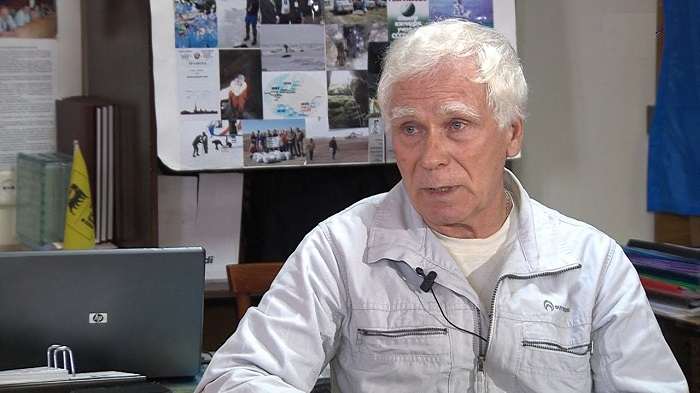According to the predictions by German and Dutch researchers, water levels in the Caspian Sea will fall by 6-7 m each year. At such a pace, the sea level will drop 9-18 m by the end of the twenty-first century. If left unaddressed this problem will lead to ecological, economic, and political instability in the Caspian region. To clarify the issue, we had a conversation with a senior researcher of the Institute of Oceanology of the Russian Academy of Sciences, leading specialist of the Water Problems Institute, a doctor in geography, professor, academic of Russian Academy of Natural Sciences Peter Bukharitsin.
- How did German and Dutch scientists come to this conclusion?
- I do not know those colleagues. I learned about their catastrophic predictions from the internet. Indeed, I was surprised by their decision to contribute to the Caspian problem, perhaps circumstantially, or in today's wave of climate change.
- There has been a tendency of water level drop in the Caspian Sea over the last couple of years. What are the reasons for falling water levels?
- In my view, it is unreal to predict what would happen after 80 years. They paid attention to climate change only in the European part of Russia. The Volga contributes over 80%, the Ural about 10 % of the total influx to the Caspian Sea. The remainder comes in from the rivers of the Caucasus and the Iranian shore. These are the primary water sources for the Caspian, as considered by almost all scientists. Everything depends on the balance of evaporation to inflow ratios.
The study of water balances is the application in the hydrology of the principle of conservation of mass, often referred to as the continuity equation. This state, for any arbitrary volume and during any period of time, the difference between total inflow and outflow will be balanced by the change of water storage within the volume. A water-balance technique is used by hydrologists studying the water-level fluctuation in the Caspian Sea.
In their calculations, our foreign colleagues cited only the climate data on the role of Atlantic cyclones that bring large amounts of water to the European part of Russia. They did not take into account that other significant factors affect the water level of the Volga and other rivers of the Caspian Sea basin, respectively, the water level of the Caspian Sea. These are the southern, the Mediterranean, the Black Sea cyclones, and the Caspian itself. They increase humidity. In comparison with Atlantic cyclones, they highly affect the water level of the rivers flowing into the Caspian Sea. Relying on the trendy model of global warming, the scientists gave such a disappointing forecast, which was refuted by their Russian colleagues.
- Are there any other predictions on the development of the Caspian region?
- Evidently, the water level of the rivers flowing into the Caspian Sea changes, and the sea level either rises or falls with short-term stability. Starting from the 1930s, another catastrophic drop was observed in the water level of the Caspian Sea. During the 1940-50s, this process was more or less stabilized. In the 1960s, the decrease continued with less intensity, and by 1977, the sea level had fallen by almost 3.5 m. Until 1996, the sea level in the Caspian Sea had risen by 2,5 m. The sea level had become more or less stable for the next few years. Then, that level again started to fall. The process continues with an overall 1,5 m drop at present. The current water level of the Caspian Sea has not yet reached the minimum level of 1977: it is one meter higher. Nevertheless, the damage has already made itself felt. However, another period will begin in the early 2030s, the water of rivers flowing into the Caspian Sea will rise, and the sea level will go up again.
- When will the situation about the decrease of the level of the Caspian Sea become stable?
- The majority believed in a downward trend of the sea level. We thought we had to save what we had. Garabogazgol was supposed to harm the Caspian, but in fact, it is a natural disaster emergency shutdown valve. When the sea level rises, about 30 km more water flows through the strait per year. Once the water level falls, the flow into the bay automatically goes down, and no one regulates it. If the sea level fell further during the 1970s, the flow to Garabogazgol would stop completely. However, people built dams and closed the bay in 1981. At that time, the sea level rose rapidly, reaching 2,5 m, and inundating large nearshore regions and many settlements. There was an urgent need for countermeasures to preserve coastal areas from floods!
It is necessary not to intervene in natural processes, especially those that have not been studied sufficiently. Nature is a system, which regulates itself, and any human intervention can cause its opposite reaction. Despite all the forecasts, we cannot change the weather. Thus, measures must be taken to adapt to climate processes, not to change them. The Caspian Sea does not need to be rescued. It has existed for thousands of years. The future of the Caspian Sea depends on natural processes, not on human activities. We must consider the lessons of history. They must not be intervened!
More about: #CaspianSea
















































